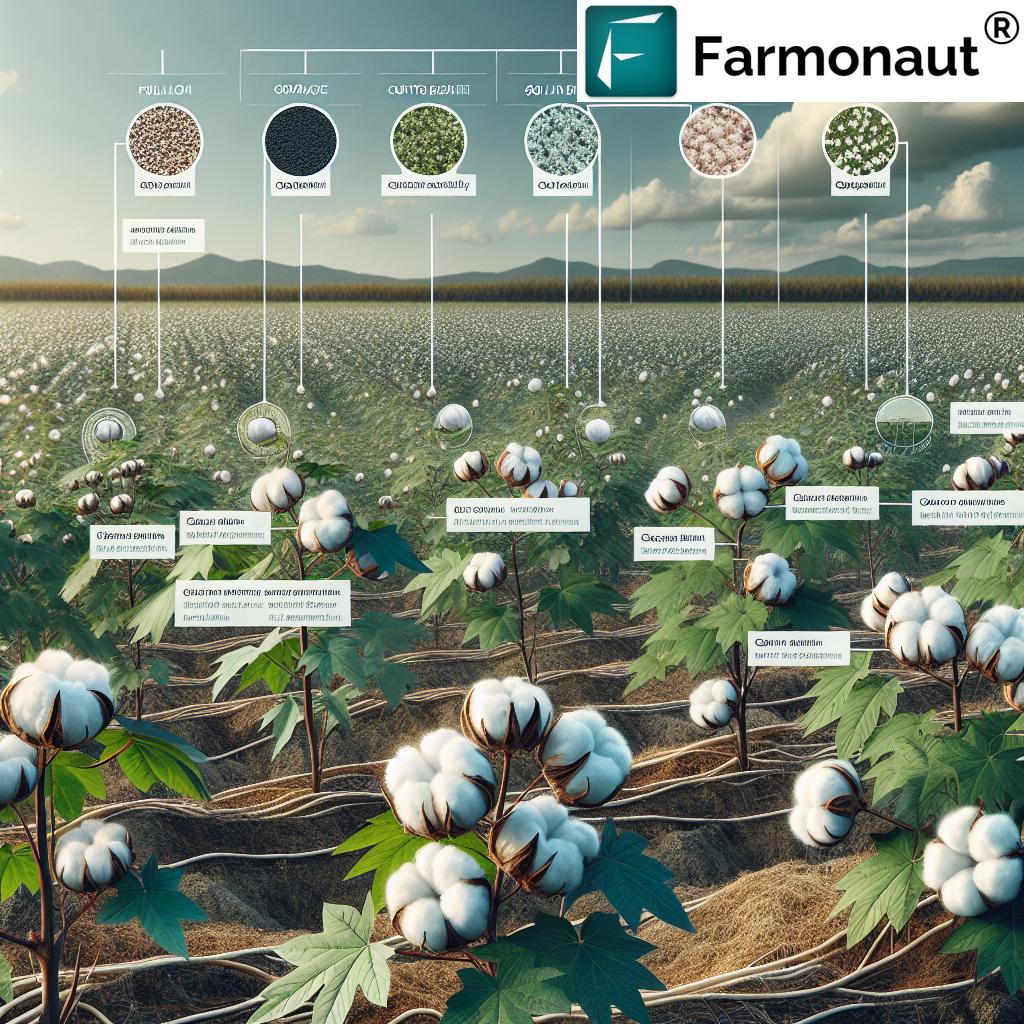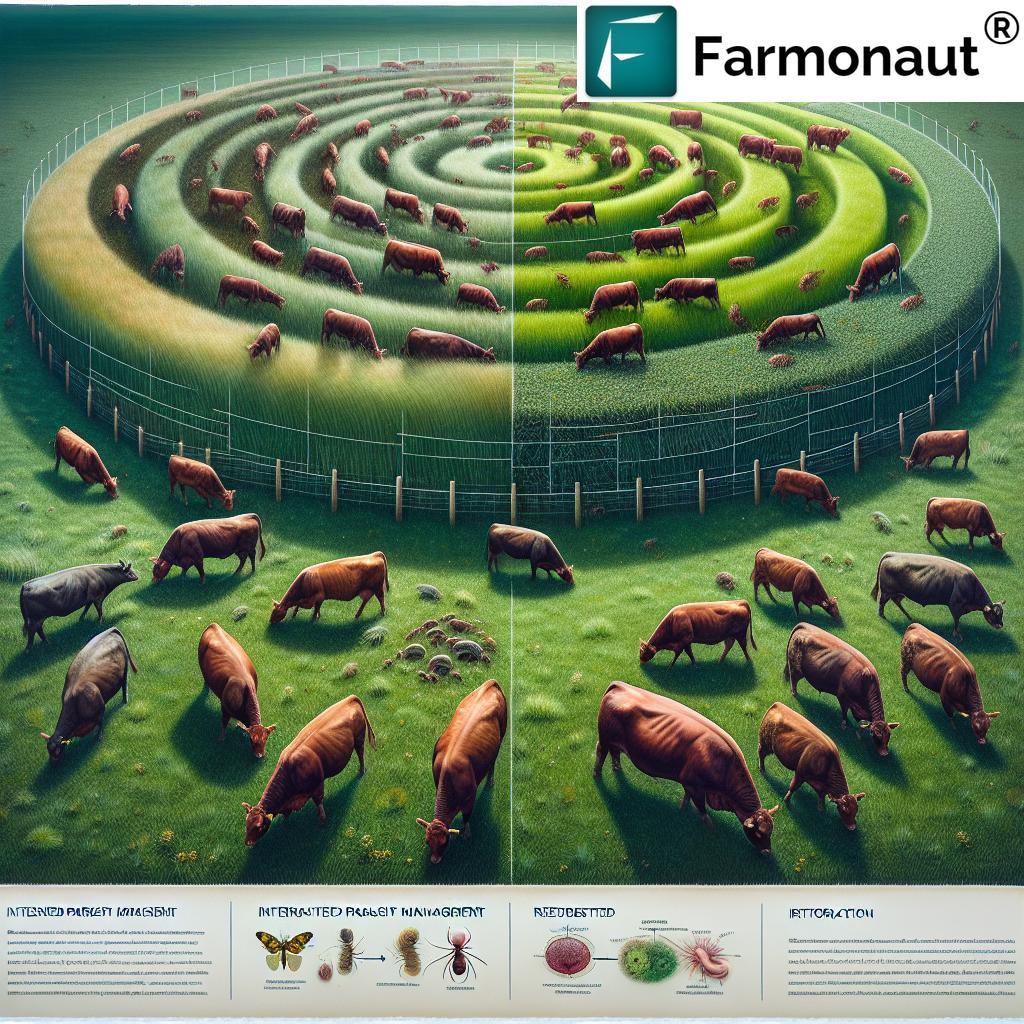Organic Carbon for Plants: 7 Ways to Boost Soil Health
Meta Description: Organic carbon is a fundamental component of soil organic matter, essential for plant health and productivity. Discover 7 practical ways to boost soil organic carbon, enhance soil fertility, prevent erosion, and promote sustainable farming practices.
“Soils with over 2% organic carbon can increase crop yields by up to 30% compared to depleted soils.”
Table of Contents
- Introduction: The Power of Soil Organic Carbon
- Chemical Benefits of Organic Carbon in Soil
- Physical Benefits: Structure and Retention
- Biological Benefits and Microbial Activity
- Impact on Soil Fertility and Crop Growth
- Preventing Soil Erosion & Climate Change Mitigation
- 7 Ways to Boost Soil Organic Carbon
- Comparison Table of Organic Carbon Enhancement Methods
- Precision Soil Health Management with Farmonaut
- Frequently Asked Questions
- Conclusion: Towards Sustainable Soil Health
Introduction: The Power of Soil Organic Carbon
Soil organic carbon (SOC) is the heart of sustainable agriculture and the backbone of healthy plant growth. As a fundamental component of soil organic matter (SOM), organic carbon encompasses a complex blend of carbon compounds derived from decomposed plant and animal residues. Its presence in the soil not only supports nutrient cycling in soils but also drives key processes that dictate soil fertility, structure, water retention, and overall plant productivity.
The global focus on sustainable farming practices has prompted us to rethink how we increase organic matter in soil and harness the benefits of organic carbon. Increasing SOC is paramount for improving soil fertility, enhancing crop growth, and preventing soil erosion—all urgent priorities as we confront food security and environmental challenges worldwide.
In this guide, we’ll explore the key roles of organic carbon in the soil, uncover the chemical, physical, and biological benefits, and, most importantly, outline seven actionable strategies that will enhance soil organic carbon and boost soil and crop health.
Chemical Benefits of Organic Carbon in Soil
How Organic Carbon Enhances Soil Properties
Organic carbon is much more than mere plant residues or decomposed matter. Its presence in soil fundamentally transforms the chemical properties that are crucial for healthy plant growth and nutrient availability.
-
Cation Exchange Capacity (CEC):
High organic carbon content increases the soil’s ability to hold and exchange essential nutrients like calcium, magnesium, and potassium. With a higher CEC, these nutrients remain more available to plants, reducing leaching and promoting efficient nutrient uptake. -
pH Buffering:
Organic carbon acts as a buffer, helping to stabilize soil pH. This protection against harmful pH fluctuations prevents conditions that would otherwise adversely affect plant health. -
Nutrient Retention & Cycling:
Through interactions with minerals, organic carbon forms stable organic-mineral complexes, further enhancing nutrient retention and availability. The decomposition of organic matter also releases nutrients like nitrogen, phosphorus, and sulfur—vital elements for crop growth.
In fact, chemical benefits of organic carbon form the baseline for improving crop productivity, reducing input costs, and minimizing environmental risks associated with excessive fertilizer use.
Physical Benefits: Structure and Retention
Organic Carbon and Soil Structure for Plant Growth
One of the most visible effects of organic carbon enrichment is the improvement in soil structure—the way soil particles aggregate and interact with air and water.
-
Aggregate Formation:
Organic matter and the exudates from microbial activity bind soil particles together, promoting aggregate formation. These aggregates enhance soil porosity, crucial for both air and water infiltration. -
Water Retention & Supply:
Soils rich in organic carbon exhibit higher water retention capacity, ensuring a consistent moisture supply for plants. This is vital for improving drought resilience and supporting root development. -
Reduced Compaction & Better Root Access:
Finished aggregates result in reduced compaction, allowing plant roots to penetrate more easily for accessing nutrients and water.
“Sustainable farming can raise soil organic matter by 0.4% annually, significantly improving soil fertility and structure.”
Biological Benefits and Microbial Activity
Supporting Microbial Life: The Foundation of Nutrient Cycling in Soils
Organic carbon serves as the primary energy source for the soil’s living ecosystem—including bacteria, fungi, and countless beneficial microorganisms. These organisms decompose organic matter and drive the nutrient cycling in soils upon which plant health and productivity depend.
-
Encouraging Diversity:
A soil rich in organic carbon develops a diverse and resilient microbial community, supporting both nutrient supply and plant disease suppression. Beneficial microbes can outcompete or inhibit pathogens. -
Continuous Nutrient Availability:
The continuous breakdown of organic compounds ensures a slow and steady release of essential nutrients, fostering robust plant growth and reducing reliance on synthetic fertilizers.
Thus, enhancing organic carbon levels fuels the intricate biological engine beneath every thriving field, orchard, or forest.
Impact on Soil Fertility and Crop Growth
How Soil Organic Carbon Helps Improve Soil Fertility
The decomposition of organic matter is a cornerstone of soil fertility. As organic carbon compounds break down, they release nitrogen, phosphorus, and sulfur—essential nutrients for crop and forestry systems. This slow-release process aligns closely with plant uptake demands, promoting both higher yields and sustainability.
-
Reducing Input Needs:
Availability of plant nutrients from organic matter decomposition reduces reliance on synthetic fertilizer, thereby protecting water resources from nutrient leaching and lowering costs. -
Organic-Mineral Complexes:
The formation of stable complexes from mineral and organic carbon interactions enhances nutrient retention and soil structure.
In summary, boosting soil organic carbon is synonymous with promoting long-term soil fertility and yield stability.
Preventing Soil Erosion & Climate Change Mitigation
Organic Carbon and Soil Structure Protect Against Erosion
Erosion—the removal of topsoil by wind or water—is a leading cause of declining soil health and fertility. Fortunately, soils rich in organic carbon are far more resistant to erosion because their structure is stabilized through aggregated particle formation.
-
Aggregate Stability:
Organic matter binds soil particles together, decreasing susceptibility to wind and water erosion. Maintaining high SOC is vital to prevent soil erosion and keep valuable topsoil in place. -
Runoff and Nutrient Loss Reduction:
Improved infiltration and stable aggregates mean less surface runoff, thus retaining both soil and nutrients for subsequent crops.
Climate Change Mitigation Through Carbon Sequestration in Agriculture
Increasing soil organic carbon also delivers a crucial ecosystem service—carbon sequestration in agriculture. By capturing atmospheric CO2 in stable soil organic matter, farms not only enhance soil quality but also contribute to climate change mitigation efforts.
-
No-Till Farming:
No-till and reduced tillage practices can raise SOC by an average of 8%. -
Cover Cropping Benefits:
Introducing cover crops increases SOC content by approximately 6%.
As the need to reduce greenhouse gas concentrations in the atmosphere intensifies, integrating these methods into everyday farming becomes even more crucial.
7 Ways to Boost Soil Organic Carbon Levels
To reap the many benefits of healthy soils and thriving crops, let’s examine seven proven ways to increase the amount of organic carbon in your soil—whether you’re in conventional agriculture, forestry, or pursuing regenerative farming. These management practices are rooted in scientific research and adaptable to diverse climates and operations.
1. Add Organic Matter: Compost, Manure & Residue Incorporation
- What it is: Incorporating compost, green manure, crop residues, and animal manure directly adds organic carbon and nutrients to the soil.
- Benefits: Boosts soil fertility, enhances SOC content, and provides a diverse nutrient profile.
- Application: Spread compost or decomposed plant matter before planting, or work crop residues into soil at the end of the season.
2. Conservation Tillage (No-Till or Reduced Tillage)
- What it is: Reducing tillage minimizes soil disturbance, protecting existing organic matter and slowing decomposition.
- Benefits: Increases soil organic carbon, conserves moisture, and improves structure.
- Application: Transition to no-till or strip-till systems adapted to your operation.
3. Planting Cover Crops
- What it is: Growing a range of cover crops (e.g., legumes, clovers, grasses) during fallow periods adds organic matter and prevents erosion.
- Benefits: Cover cropping benefits include higher SOC, improved structure, reduced nutrient leaching, and support for beneficial microbes.
- Application: Seed cover species after harvest or before planting main crops.
4. Diversification & Crop Rotation
- What it is: Employing crop rotation and diversifying crops increases the range of residues and root exudates entering the soil.
- Benefits: Maintains and increases soil organic carbon, supports nutrient cycling, and prevents pest build-up.
- Application: Plan multi-year rotations with a variety of deep- and shallow-rooted crops including legumes for added nitrogen fixation.
5. Maintain Permanent Vegetative Cover (e.g., Pastures, Agroforestry)
- What it is: Keeping the soil always covered with living vegetation reduces erosion and adds organic matter through continuous root and aboveground biomass.
- Benefits: Protects soil, increases SOC, and improves soil structure and plant growth.
- Application: Utilize perennial grasses, shrubs, or tree-based systems.
6. Precision Nutrient Management
- What it is: Using soil data (like those available via Farmonaut’s satellite-based monitoring) to minimize overuse and loss of fertilizers, thus supporting organic matter buildup.
- Benefits: Reduces unnecessary nutrient application, supports efficient nutrient cycling, and prevents adverse impacts on soil health.
- Application: Employ soil testing, satellite insights, or sensor-based platforms to guide targeted inputs.
7. Avoiding or Reducing Soil Compaction
- What it is: Managing field traffic, avoiding tillage when soil is wet, and using lighter machinery limits compaction, which preserves pore structure, microbial habitats, and SOC content.
- Benefits: Sustains organic carbon storage, enhances plant root growth, and maintains infiltration and retention properties.
- Application: Restrict vehicle movement, deploy controlled traffic, and adopt practices that keep the soil loose and friable.
Comparison Table of Organic Carbon Enhancement Methods
| Method | Estimated Organic Carbon Increase (%) | Key Benefits | Implementation Difficulty | Environmental Impact |
|---|---|---|---|---|
| Organic Matter Addition (Compost, Manure) | 5–12% | Fertility boost, enhanced microbial activity, increased water retention | Easy–Moderate | Positive |
| Conservation Tillage (No-Till) | 6–10% | Improved structure, reduced erosion, climate change mitigation | Moderate | Positive |
| Cover Cropping | 4–8% | Prevents erosion, supports microbes, nutrient cycling | Easy–Moderate | Positive |
| Crop Rotation & Diversification | 2–6% | Continuous input diversity, pest and disease suppression | Moderate | Positive |
| Permanent Vegetative Cover | 3–7% | Erosion reduction, soil structure and plant growth | Easy | Positive |
| Precision Nutrient Management | 2–5% | Efficient use of resources, less leaching | Moderate | Positive |
| Reducing Soil Compaction | 1–4% | Better root growth, sustained SOC, increased porosity | Easy | Positive |
Precision Soil Health Management Practices with Farmonaut
As we look to optimize soil health management practices, precision, affordability, and cutting-edge insights are critical. At Farmonaut, we are dedicated to making precision agriculture accessible worldwide, harnessing satellite imagery, AI, and real-time data for effective soil organic carbon management and sustainable farming practices.
-
Satellite-Based Crop Health Monitoring:
We utilize multi-spectral satellite imagery to analyze soil moisture, crop health, and identify areas needing intervention. This helps farmers respond proactively with optimal inputs, preserving both soil organic carbon and farm profitability. -
Jeevn AI Advisory System:
Our AI system integrates weather forecasts, soil sampling, and agronomic models to offer actionable advice—for instance, on when and how to add organic matter or select the right cover crops. -
Carbon Footprinting Support:
We help you monitor carbon emissions and track sequestration, making it easier to participate in carbon markets or climate-smart certification schemes.
More on Farmonaut’s Carbon Footprinting solutions -
Blockchain-Based Traceability:
From farm to consumer, blockchain ensures you maintain transparent, verifiable supply chains, enhancing your product’s sustainability credentials.
Read about Farmonaut’s Product Traceability Solutions -
Fleet & Resource Management:
For larger operations, managing logistics efficiently lets you minimize soil compaction and apply inputs precisely where needed.
Learn about Farmonaut Fleet Management Platform
Interested in integrating Farmonaut’s advanced satellite data and weather API into your ecosystem?
Explore our API
or dive into our
API Developer Docs
for seamless agritech innovation.
Farmonaut Subscription Pricing
Access affordable, scalable farm management solutions for individuals, cooperatives, and enterprises. The platform provides instant insight into soil moisture, crop health, weather patterns, and more.
Frequently Asked Questions (FAQ)
Soil organic carbon is the carbon component in soil organic matter derived from decomposed plant and animal residues. It is crucial as the primary energy source for soil microorganisms, driving nutrient cycling, supporting soil structure, and enhancing fertility. Healthy levels of SOC underpin productive, resilient agricultural and forestry systems.
Q2: How does increasing organic carbon in soil benefit crops?
Higher organic carbon levels boost cation exchange capacity (CEC), stabilize soil pH, improve water retention, enhance microbial activity, and slow the release of essential nutrients like nitrogen and phosphorus—directly contributing to better crop growth and yields.
Q3: Which management practices most efficiently increase soil organic matter?
Incorporating compost, manures, crop residues, planting cover crops, reducing tillage, rotating and diversifying crops, and precision input management are the most effective and sustainable practices to elevate soil organic matter content.
Q4: Can organic carbon improvements help with climate change mitigation?
Yes! By increasing soil organic carbon, farms can sequester more atmospheric CO2, helping in the fight against climate change. Soil carbon sequestration achieved through no-till, cover cropping, and permanent vegetation are vital strategies for global sustainability efforts.
Q5: How can technology support sustainable soil health management?
Farmonaut leverages satellite imagery, AI-based advisories, and carbon footprinting to give precise, real-time feedback, enable data-driven decisions, monitor crop and soil health, and track resource use for more sustainable and productive farming.
Conclusion: Towards Sustainable Soil Health
Organic carbon is much more than a numeric indicator—it is the living foundation of healthy agricultural and forestry systems. Its profound influence spans chemical, physical, and biological properties, all crucial for robust plant growth and ecosystem resilience.
By adopting proven soil health management practices—adding organic matter, minimizing tillage, planting cover crops, rotating crops, maintaining constant vegetative cover, implementing precision nutrient management, and avoiding soil compaction—we can significantly enhance soil organic carbon levels. This delivers cascading benefits: improved soil fertility, higher productivity, erosion prevention, and vital contributions to climate change mitigation efforts.
For those seeking actionable insights and affordable precision tools, our mission at Farmonaut is to democratize access to satellite-based farm management, AI advisory, resource tracking, carbon footprinting, and supply chain traceability—making sustainability a reality for every field and farm.
Ready to elevate your soil health and crop productivity?
Access our platform on Web, Android, iOS or Large Scale Farm Management for government, corporate, and institutional users.
For forest growers and plantation management, our specialized Forest & Plantation Advisory keeps you steps ahead.
Discover the benefits of smarter, greener farm management—today and for generations to come.













